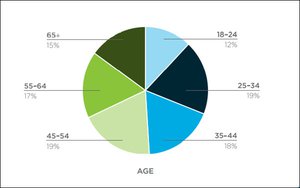
Connected TV consumers are widely on-board with
accepting advertising if it means getting free content, confirms a new survey conducted for SpotX.
Mintel surveyed a nationally representative sample of 1,500 CTV consumers 18 and older who
said they watch CTV at least once per month.
While the research was fielded in February, prior to the pandemic-driven surge in streaming, it provides pre-COVID consumption benchmarks, and
perhaps more important, behavioral and demographic insights about CTV consumers that aren’t likely to have lost their relevance over the past few months.
Here's a look at some of those
insights and pre-pandemic consumption benchmarks, including some comments from an interview with SpotX COO Sean Buckley.
Substantial Advertising Acceptance
Fully 85% reported
currently subscribing to at least one paid streaming service — and 79% specifically reported subscribing to Netflix. More than half (56%) reported subscribing to cable, 36% were cord cutters,
and 8% were cord nevers.
advertisement
advertisement
At the same time, four out of five, or 80%, reported watching at least some ad-supported CTV programming.
And when asked, "Are you more likely to choose
the free ad-supported version of a streaming service or pay for an ad-free experience?," 60% said they were more likely to choose the free version with ads.
Results also seem to indicate
that CTV ad personalization is seeing some success. Nearly 60% of respondents said they’d seen ads that they have an interest in, 17% said they’d considered making a purchase because of an
ad they’d viewed, and 12% said they’d actually made a purchase because of an ad.
While 42% of CTV viewers said they dislike seeing ads, 58% reported generally positive
attitudes about ads based on ads making it possible for them to watch free content, being entertained by ads, and ads providing information about brands they’re interested in and informing their
purchase decisions.
“As technology has improved, video advertising is becoming more personalized and relevant for viewers,” says Buckley. “The combination of the growth in
time spent watching streamed programming [see below] and four out of five viewers saying they watch ad-supported content is the strongest indicator that the audience is actively embracing ad-supported
programming.”
In terms of negative responses to ads, 36% said their biggest issue is being shown the same ad too many times, and 28% said they find it creepy when ads
“follow” them from one screen to another, including on CTV. Importantly, nearly three quarters (71%) said they’re concerned about how their personal information is being used for
advertising purposes.
“Generally speaking, the results indicate that there is an acceptance toward ads being shown, especially in order to provide free-to-view content, and that
consumers find value in entertaining and personally relevant ads,” sums up the report. “However, media companies
and advertisers should be mindful of over-exposure and respect consumer privacy protections.”
Viewing Time High Even Pre-COVID
Even before shelter-at-home, this research
found 63% of respondents reporting that they watch CTV every day, for three hours on average, and 94% watching at least weekly. Viewing hours per week averaged 23.
SpotX doesn’t have any
of its own previous comparative data — this is the company’s first consumer study on CTV — but Buckley notes that Nielsen found the average time per day to be just 46 minutes as of
2018.
In comparison, Nielsen reports that traditional broadcast TV viewers watch an average of 35.5 hours per week, but "most of the incremental hours are largely driven by the 55+ age group,
given that the median age of live linear broadcast TV viewers is 58.7 years,” points out the report.
Device-wise, 54% access CTV through smart TVs, 37% through streaming devices, and the
rest through gaming consoles.
Thresholds for Costs, Number of Subcriptions
As of February, most reported spending between $4 and $29 per month for paid streamers, although some
were spending up to $69 per month in total. Very few were spending above that threshold.
A third (32%) subscribed to two services, and about a quarter each subscribed to one service or three
services.
Most said that four was the maximum number of services to which they would subscribe, and 80% didn’t intend to increase their spending on subscriptions in the next 12
months.
Still, most respondents cited flexibility and variety as the primary reasons they watch CTV, with affordability taking third place.
Bottom line: CTV viewers said they
were are looking for ways to increase access to content without increasing cost.
“America’s appetite for streamed video is strong. However, consumers’ willingness to
pay for content is limited to a select few subscription services,” sums up the report. “Ad-supported content provides streamers with a wider choice of options, and CTV viewers are
enthusiastically embracing it.”
Diverse Audience
Contrary to what some might assume, the CTV audience is not skewed to younger segments. Among U.S. CTV
consumers, the median age is 45, and the audience is fairly evenly distributed across age segments:

Caucasians dominate the audience, but 30% of viewers are of other ethnicities, with 36% of that
30% made up of Hispanics, 10% of African-Americans, 3% of Asians and 2% other.
Income-wise, 42% of CTV consumers earn more than $75,000, compared to 43% of the general
population.
"Advertisers should follow the audience,” argues the report. “Traditional TV remains the number one choice for achieving scale, but… it is a graying
audience and gradually becoming less reflective of America’s dynamic society. CTV mirrors our national consumer makeup – diverse, digital, and demanding. It has become the ideal way to
reach specific audiences effectively at scale.”
The researchers also used the results to develop CTV audience segment profiles through a separate segmentation study.